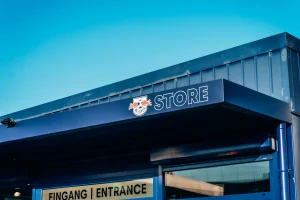Why AI Foot Traffic Analysis Determines Store Success
In retail, foot traffic directly affects sales potential.
- High traffic brings more conversion opportunities.
- But if traffic doesn’t lead to sales, stores face high costs and low margins.
Traditional store management often relies on experience, but that’s not enough for today’s complex consumer behavior.
Modern retailers rely on retail foot traffic analysis to connect in-store movement with sales and marketing outcomes.
AI foot traffic analysis solves this by combining AI and IoT technologies to understand customer paths, dwell time, and interests — turning raw movement data into actionable insights that drive store optimization.
Challenges of Traditional Foot Traffic Counting
- Manual counting is inaccurate
- In malls or supermarkets, manual clickers can have up to 20% error.
- They also can’t reflect peak-hour or zone-level differences.
- Limited data
- Basic infrared sensors only count entries and exits — not age, gender, or movement patterns.
- No real-time response
- When a zone becomes crowded or a display area is empty, traditional systems can’t react instantly.
- Data silos
- Even when data exists, it’s not integrated with sales or inventory systems, providing no actionable insights.
As a result, retailers see people but not behavior, and can’t link traffic to revenue.
How AI Enhances Foot Traffic Analysis and Visualization
AI transforms simple counting into behavior-level analytics. AI systems collect and process retail foot traffic data in real time, enabling managers to visualize how visitors move through different store zones.
1. Real-Time Traffic Counting
- Camera + AI detection tracks customer entry and exit in real time.
- Unlike infrared sensors, AI avoids errors when multiple people walk together.
2. Zone Heatmaps
- Dwell time and movement paths generate store heatmaps, showing hot and cold zones clearly.
3. Demographic Recognition
- Computer vision identifies age group and gender, supporting targeted promotions.
- Example: young shoppers stay longer in electronics; seniors prefer health products.
4. Path and Conversion Tracking
- AI traces full in-store routes and connects them with POS data to reveal conversion rates.
- This highlights “high traffic, low conversion” problem areas.
Understanding Customer Behavior Through AI
Through advanced customer behavior analysis, AI reveals how dwell time and engagement translate into purchase intent.
One of the biggest advantages of AI foot traffic analysis is uncovering deep customer behavior analysis.
By mapping movement, dwell time, and repeat visits, AI helps retailers:
- Identify peak engagement zones.
- Predict purchase intent through dwell-time patterns.
- Correlate behavior with demographics and product categories.
This provides a data-driven foundation for store optimization and marketing personalization.
AI Traffic Analysis Workflow
graph TD A["🎥 Camera / Sensor Data"] --> B["🤖 AI Detection & Tracking"] B --> C1["👥 Entry/Exit Counting"] B --> C2["⏱️ Dwell Time Analysis"] B --> C3["🧑🤝🧑 Demographic Recognition"] B --> C4["➡️ Path Tracking"] C1 --> D["📊 Real-Time Dashboard"] C2 --> D C3 --> D C4 --> D D --> E["🏬 Store Layout Optimization"] D --> F["🎯 Targeted Marketing"] D --> G["🛡️ Staffing & Safety Alerts"]
Practical Value
- Layout Optimization
Heatmaps guide shelf placement and digital signage positioning. - Targeted Marketing
Personalized promotions based on demographic and behavior data.
Example: promote new beverages in areas with young visitors. - Staff Management
Real-time alerts for peak hours help managers adjust staffing. - Safety Monitoring
Automatic alerts when zones become overcrowded.
Core Technologies
1. Computer Vision for People Detection
- Object Detection (YOLO, EfficientDet, Faster R-CNN) identifies people in frames.
- Multi-Object Tracking (MOT) (DeepSORT, ByteTrack) avoids duplicate counting.
- Pose Estimation determines whether customers stop or pass by.
This turns counting into spatial behavior analytics. Learn more about computer vision use cases in smart retail from NVIDIA’s developer guide.
2. Heatmaps and Path Analysis
- Heatmaps visualize “hot” and “cold” zones.
- Path modeling tracks full in-store movement.
- Dwell classification (e.g., quick pass, stop, long stay) reveals customer interest areas.
3. Multi-Sensor Data Fusion
- Infrared sensors help count entries when cameras are blocked.
- Wi-Fi/Bluetooth probes detect mobile signals for dwell time estimation.
- Floor pressure sensors track exact footsteps.
Combining these boosts accuracy to 95–98%.
4. Edge Computing
- On-site AI inference (Jetson, TPU) avoids cloud delays.
- Only event data is sent to the cloud — not video streams.
- Enables real-time alerts and low-latency decisions.
5. Customer Profiling
- Age & gender classification (anonymized).
- Behavioral correlation with POS data predicts purchase intent.
- Segmentation for high-value, casual, and repeat customers.
6. Business System Integration
AI traffic analytics links with:
- POS for conversion tracking.
- ERP/scheduling for auto workforce planning.
- Marketing systems for location-based campaigns.
AI-driven foot traffic analysis maps customer movement patterns and integrates with AI retail security systems to enhance both store safety and shopper experience.
Key Customer Concerns
1. Cost and ROI
- Hardware: Cameras, edge devices, and sensors (~USD $15K–30K).
- Software: SaaS or on-premise (~USD $3K–10K/year).
- ROI: Usually within 12–15 months, driven by:
- Higher conversion rates
- Optimized staffing
- Better ad targeting
2. Accuracy and False Positives
- Vision accuracy: 95%+, multi-sensor fusion: 98%+.
- Solved via camera placement, sensor redundancy, and retrained models.
3. Data Privacy and Compliance
- Anonymized detection, no face storage.
- On-premise data storage to meet privacy laws (GDPR, PIPL).
- Transparency via clear signage to inform customers.
4. Acceptance and Perception
- Employees fear surveillance — clarify that it’s for traffic insights only.
- Customers may worry about privacy — highlight service improvement, not monitoring.
5. Business Impact
- Layout adjustments increase traffic flow to underperforming areas.
- Targeted ads improve ROI.
- Real-time staffing saves costs.
- Safety alerts prevent incidents.
ROI, Privacy, and Real-World Value
| Focus | Key Question | Value |
|---|---|---|
| Cost & ROI | How fast can we recover investment? | 12–15 months |
| Accuracy | Will the system miscount? | Up to 98% precision |
| Privacy | Is it compliant? | Anonymized + local data |
| Acceptance | Will users feel monitored? | Transparent communication |
| Business Impact | Does it increase sales? | Yes, via layout and conversion optimization |
Retail decision-makers care most about one thing:
“Can this data actually improve conversion and efficiency without privacy risks?”
The answer is yes — AI foot traffic analysis bridges the gap between physical space and data-driven decision-making.

These AI-driven retail data insights allow decision-makers to plan campaigns and store operations with greater accuracy and confidence.
To comply with privacy regulations, retailers typically follow the GDPR framework for data anonymization and consent transparency.
What Matters to Retail Decision-Makers
The ultimate question is:
“Can this data actually improve conversion and efficiency without privacy risks?”
- Headquarters want cross-store analytics and centralized control.
- Store managers need clear, actionable results.
- Employees need reduced workload.
- Customers expect better experiences, not surveillance.
AI foot traffic analysis bridges the gap between physical space and data-driven decision-making — helping retailers turn every visit into measurable business value.
Integrating AI Foot Traffic Insights into Retail SaaS Platforms
For retailers using digital tools, the real power comes when AI retail analytics integrates seamlessly into a retail SaaS platform.
This integration enables:
- Centralized dashboards to compare multiple store locations.
- POS & ERP data correlation for conversion tracking.
- Smart staffing and scheduling via automated insights.
- Marketing automation triggered by in-store behavior data.
Learn more about how AI traffic analytics connects to retail management systems in our Retail SaaS Platform solution.
Build Your AI-Powered Retail SaaS Platform
AI foot traffic analysis isn’t just about counting people; it’s about understanding what drives sales, loyalty, and operational efficiency.
By integrating AI analytics into your retail SaaS platform, you unlock data-driven retail intelligence for every store.

FAQ: Common Questions About AI Foot Traffic Analysis
Q1: What is AI foot traffic analysis in retail?
AI foot traffic analysis uses computer vision and IoT sensors to track store visitors, measure dwell time, and map movement paths. Combined with POS/ERP data inside a Retail SaaS Platform, it turns raw movement into actionable insights for store layout, staffing, and marketing.
Q2: How does AI improve retail SaaS performance?
AI enriches a retail SaaS platform with real-time heatmaps, conversion insights, and automated alerts. By correlating foot traffic with sales and inventory, it drives smarter staffing, merchandising, and campaign decisions—improving efficiency and revenue.
Q3: Can AI foot traffic analytics protect customer privacy?
Yes. Modern systems anonymize detections, avoid face storage, and process video at the edge. Only event data is retained. Clear in-store signage and on-premise storage help meet privacy regulations like GDPR or local equivalents.
Q4: What ROI can retailers expect from AI foot traffic analytics?
Typical ROI is achieved within 12–15 months, driven by higher conversion rates, optimized staffing, and better-targeted promotions. Multi-sensor fusion and improved camera placement also reduce miscounts and operational waste.
Q5: How do AI insights integrate with existing systems?
AI foot traffic insights connect to POS and ERP via APIs inside your retail SaaS platform. This enables centralized dashboards, cross-store benchmarking, automated workforce scheduling, and marketing triggers based on in-store behavior.

